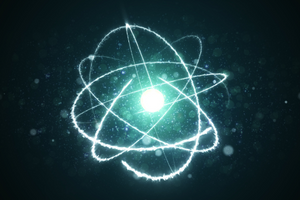Atoms are the tiny units that make up all the matter in the universe. The energy of an atom is concentrated in its nucleus. It is the force that holds the components of the nucleus together. A large amount of energy is stored in the atomic nucleus. In order to be transformed, for example, into electricity, it must be released from it. This happens in the process of fission of atomic nuclei.

From nuclear energy to electricity
A nuclear reactor, or a nuclear power station, is where nuclear energy is produced. In individual elements of this system, the processes of fission of atomic nuclei are carried out. The fuel used for this purpose is usually ane isotope of radioactive uranium, 235U. In a nuclear reactor, uranium nuclei are forced to decay, releasing tiny particles called fission products. In a nuclear reactor, they collide with other uranium isotopes, thus starting a chain reaction. During the process, a lot of heat is generated in a nuclear reactor. It is transferred to a coolant. This usually is water, which is heated by the received heat. The result is steam that drives turbines of a turbogenerator. This way, nuclear energy is converted into electricity, which is the most important application of nuclear energy today.
Using nuclear energy to produce hydrogen
Hydrogen is considered to be the fuel of the future. It turns out that the energy released during the fission of the nuclei of radioactive elements can be successfully used to obtain this valuable molecule. The vast majority of it is produced from natural gas in the steam reforming process. The concept of using nuclear energy to produce hydrogen assumes that the heat generated in the reactors will be transferred to the processing of natural gas through steam reforming. However, this approach can generate large amounts of carbon dioxide, which is released into the atmosphere. Therefore, other methods, such as electrolysis, are being improved.
Hydrogen is obtained in the process of electrolysis of water. Only small amounts of H2 are produced by this method. It is possible to connect electrolytic cells to nuclear power plants to obtain hydrogen using a low-emission method. Such solutions are still in the testing phase. The heat and electricity needed could be obtained from nuclear energy. Some research focuses on the production of hydrogen from water, using the thermochemicalmethod.
Nuclear energy as a source of propulsion
The use of nuclear fuel allows for obtaining much more energy compared to conventional sources. Nuclear energy has been used as a source of propulsion for ships and spacecraft for several decades.
In aircraft, the idea of nuclear propulsion has not been fully implemented. High risk associated with the use of nuclear energy in aircrafts prevent the implementation of nuclear propulsion. The situation is similar in the case of cars.
The idea of nuclear propulsion in passenger cars has been considered for a long time. However, placing a nuclear reactor, , which will be the source of propulsion, in a vehicle, is associated with a huge risk. Such a reactor would be a neutron generator. They are highly penetrating particles of ionizing radiation. Neutrons would not only be a threat to the people inside the vehicle, but also those in its vicinity. Safety and other design difficulties cause nuclear propulsion to be currently extremly difficult to implement in passenger cars.
In 1946, the construction of the first American nuclear-powered submarine began. This idea turned out to be a great success. Similar solutions were then used in the Soviet icebreaker “Arktika”. Currently, a significant part of civil and military ships use nuclear energy as a source of propulsion.
Nuclear energy in medicine
The currently conducted diagnostics and therapies of various diseases with the use of nuclear energy give hope for its more effective use in the future. Research is being conducted on its use to also eliminate the effects of various diseases.
An example of the use of nuclear energy in medicine can be X-ray diagnostics, which consists in recording the radiation produced by the X-ray tube, weakened due to a partial absorption by the patient’s body. The X-ray machines used make it possible to take pictures of, for example, a chest or a skull.
Nuclear energy is also used in the production of many medicines, in balneology (e.g. therapeutic baths), as well as in the sterilization of medical and laboratory equipment.
Other uses of nuclear energy
- The phenomena of radioactive decay have found a wide application in the production of efficient power batteries.
- In space science, nuclear energy is used to propel space probes that are designed to explore the solar system.
- In scientific research, it enables the dating of archaeological and palaeontological excavations.
- Nuclear energy is used in water desalination processes. This method is of particular importance in countries that have scarce drinking water resources.
- It is also used to detect pollution in rivers or lakes.
